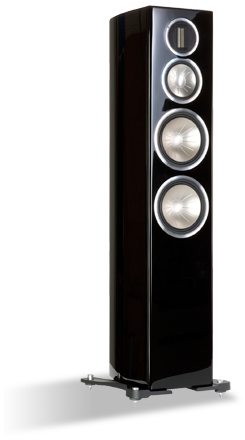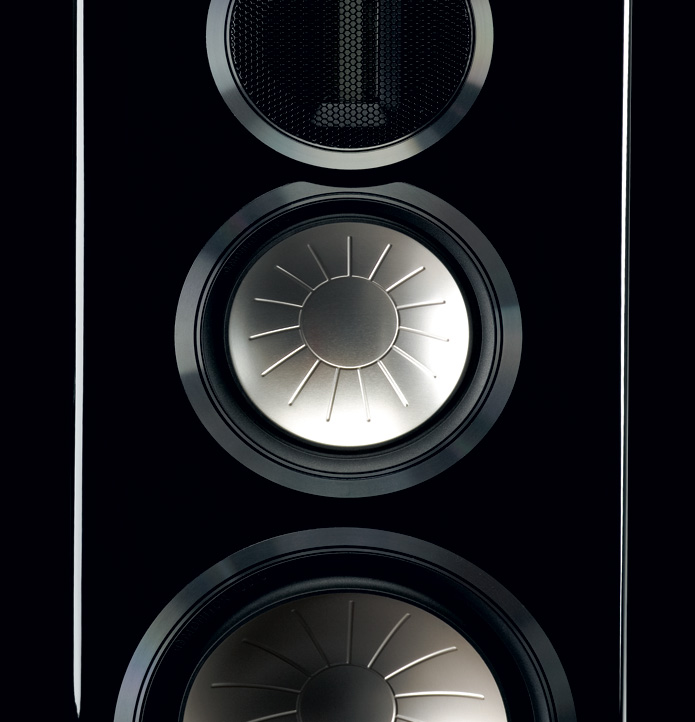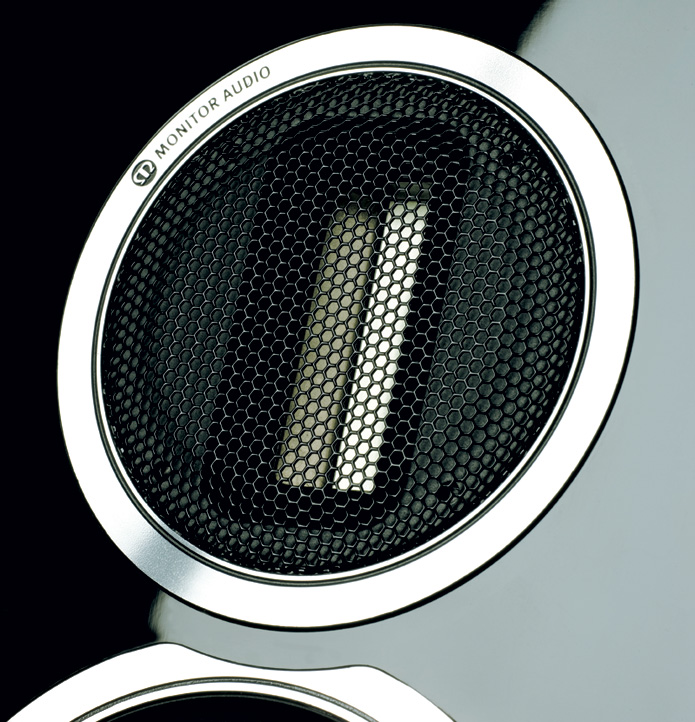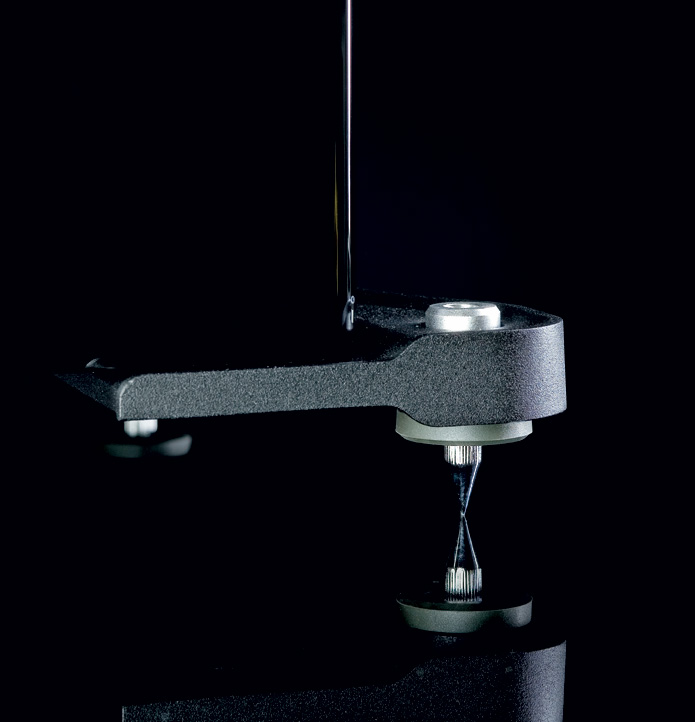 Last year, when I reviewed Monitor Audio’s Silver RX6 loudspeaker, I was a bit dumbfounded by the vast improvement over the outgoing Silver RS6 -- everything was new from the ground up, including the sound. So when I was asked if I would be interested in reviewing Monitor’s new Gold GX-series flagship, the Gold GX300, I was intrigued. I’d had a small glimpse of what I might expect from this redesign of the Gold GS60 at the 2011 Consumer Electronics Show. At that time, the Gold GX line had yet to be released, but here they were on active display -- I sat and listened. But as I took my seat, a thought ran through my head: Would the gains in performance from the GS60 to the GX300 be anything like what I heard from the RS6 to the RX6?
Last year, when I reviewed Monitor Audio’s Silver RX6 loudspeaker, I was a bit dumbfounded by the vast improvement over the outgoing Silver RS6 -- everything was new from the ground up, including the sound. So when I was asked if I would be interested in reviewing Monitor’s new Gold GX-series flagship, the Gold GX300, I was intrigued. I’d had a small glimpse of what I might expect from this redesign of the Gold GS60 at the 2011 Consumer Electronics Show. At that time, the Gold GX line had yet to be released, but here they were on active display -- I sat and listened. But as I took my seat, a thought ran through my head: Would the gains in performance from the GS60 to the GX300 be anything like what I heard from the RS6 to the RX6?
Evolution
At least the evolution of the Gold GS60 into the Gold GX300 is similar to that of Silver RS6 into the Silver RX6. Everything in the GX300 is different than in the GS60, from the size and shape of the cabinets to the design and performance of the drivers. I removed the GX300s from their substantial packaging, installed the requisite two-piece plinths, and began my search for the best places for them in my room. While doing so, I couldn’t help stopping every now and then to gawk at the speakers -- their finish quality, new cabinet shape, and flush-mounted driver array together produce a svelte, elegant, downright classy-looking speaker. That’s not to say that the exterior of the GS60 wasn’t exquisitely finished, but let’s face it: basically, the GS60 was a box.
The Gold GX300’s cabinet is tapered and curved, and finished -- in all new veneers -- to a level that approaches that of Monitor Audio’s higher-priced Platinum series. In fact, when I touched base with Sheldon Ginn, Monitor’s director of sales and marketing, at this year’s CES, I noticed that the GX300s on display were in fact veneered in the same Piano Ebony currently available for the Platinum models. Ginn told me that this finish will be made available for all GX models in the first quarter of 2012 to anyone who asks for it, at a 20% surcharge. The GX300 is also available in five standard finishes: Dark Walnut, Natural Oak, Bubinga, and Piano Gloss Black or White, all at $5500 USD per pair.

Look at the 60-pound GX300 from the front and you see four flush-mounted drivers: two 6.5” woofers, a 4” midrange cone, and a large ribbon tweeter. These make the speaker look smaller than it is. Look at it from the rear and you’re suddenly aware of its size (43.5”H x 12.5”W x 14.5”D) -- there’s nothing back there but four small, polished driver tensioners to accentuate the cabinet’s curves and size. Also on the back, toward the base of the speaker, is a single port tuned to 40Hz that’s based on Monitor’s HiVe II port technology. Directly below that is a panel of die-cast alloy for the high-quality biwire binding posts and high-end, spade-terminated jumper cables.
Although the new cabinet design is claimed to be an integral part of the Gold GX300’s sound, it’s what’s inside that makes it special. To give me the scoop on that, at this year’s CES Ginn put me in touch with Monitor Audio’s technical director, Dean Hartley, who took me through all of the new components and design of the GX300. He began with the cabinets, which are built using multiple layers of 3mm-thick, high-density fiberboard (HDF). Those layers, joined by high-strength adhesives, are steam-pressed in a tool to form a rigid plywood shell 21mm thick. Hartley noted that while this makes for an incredibly rigid structure, the curved panels also reduce internal standing waves. Radial internal braces increase the rigidity, working together with the single-bolt-through driver technology that Monitor now uses in all its speakers. This enhances cabinet rigidity by providing additional front-to-back bracing while maintaining consistent tension for the driver. This in turn reduces vibrations from the drivers and cabinet, thus reducing colorations across the entire audioband. Not only that, it allows all of the drivers to be firmly installed into the cabinet without the direct use of any mechanical fasteners: the bolt from the rear clamps the driver to the baffle.
Hartley pointed out that, contrary to rumor, the new 6.5” RST drivers used in the Gold GX300 are not direct descendants of those used in the Platinum range, but are closer to those found in the Silver RX series, with some enhancements. The Platinum cones have a sandwich structure comprising three layers, two of which are of Monitor’s Ceramic-Coated Aluminum/Magnesium (C-CAM). The drivers used in all Gold GX models, similar to those in the GS and RX series, have only a single layer of C-CAM, but differ from the Gold GS60’s drivers in that the new cones are ribbed rather than dimpled. This, Hartley said, makes for a stiffer, lighter cone while offering a significant decrease in cone breakup, better damping of the main breakup mode, and a much purer sound overall. Finite-element analysis was used to determine the rib arrangement that provided optimal rigidity. The result is an increase of 1.5kHz before cone breakup occurs over the Gold GS series. The new drivers also have new chassis of die-cast alloy, with improved venting to keep the driver cooler while reducing internal pressure. This, Hartley claimed, lets the Gold GX drivers play louder with lower distortion than earlier designs, and, in the case of the GX300, extend down to a claimed 30Hz.
Hartley then talked about the new midrange driver, a 4” C-CAM cone propelled by a short voice-coil that’s underhung in relation to the magnetic gap, which, he said, significantly reduces modulation effects and, therefore, distortion. Additionally, the diameter of the voice-coil was enlarged to 40mm in an effort to provide greater power handling and lower power compression at high SPLs. Although this all sounds like the recipe for a midrange driver designed to cross over to the tweeter quite high in the audioband, this one takes over from the twin bass drivers at 790Hz, then quickly transitions to the tweeter at 2.3kHz.

That tweeter, which is used throughout the Gold GX range, is a newly designed C-CAM ribbon transducer largely based on the one used in the Platinum range. To use the same driver while extending its range lower than in the Platinum models, Monitor had to make some changes -- like most ribbons, the Platinum tweeter produced exponentially more distortion when pushed below 4kHz. To fix this, Monitor Audio uses slightly thicker C-CAM for the ribbon, which allows it to dig all the way down to 2.3kHz and up to 60kHz, to far exceed the GS60 tweeter’s upper limit of 35kHz. What’s more, this thicker ribbon also permits greater power handling and better off-axis performance. Such an approach makes a lot of sense on paper, but I was curious to learn what other rabbits Monitor Audio had to pull from its design hat to endow the Gold GX tweeter with such a wide frequency response. In response, Hartley had this to say:
In order to help this ribbon perform optimally at these frequencies, we have developed a new type of suspension system to counter the ribbon stretch when it expands and contracts due to low-frequency excursion and heat. This ensures more consistent performance and reliability, and enables this lower-than-normal crossover point. As well, we have managed to develop the ribbon tweeter to eradicate this stretch without making the ribbon too large. A longer ribbon would cause a significant problem with reduction in vertical off-axis performance.
I also asked Hartley about the new third-order crossover designed for the GX300. He told me that it was new from the ground up, and that almost countless hours of listening and comparison tests were performed before the designers settled on a combination of high-quality components: polypropylene film capacitors, air-core and laminated steel-core inductors, and the same high-grade, low-tolerance film capacitors used in the Platinum series. The new network, which allows the GX300 to operate as a true three-way design, connects with all drivers via Pureflow silver internal wiring.
Breaking the mold
With my impressions of hearing the Gold GX50 at CES 2011 still in my head, I greatly anticipated what the Gold GX300 had in store for me, and I didn’t have to wait long -- the GX300s were very easy to position in my 25’L x 15’W listening room, thanks to their ribbon tweeters’ excellent dispersion characteristics. After just ten minutes of tweaking, I settled on placing the GX300s 2’ from the front wall, with at least 8’ between each speaker and the nearest sidewall, and barely 10 degrees of toe-in. With the speakers and my listening seat describing an almost perfectly equilateral 8’ triangle, I was ready to go.
I often like to listen to slower, mellower recordings at the start of a listening session. This time I began with Tom Jones’s cover of Bob Dylan’s “What Good Am I?,” from Praise & Blame (CD, Lost Highway B001455502). At center stage, Jones’s voice sounded big, raspy, and three-dimensional. To his left, an acoustic guitar had an uncanny naturalness. The sound of the strings was so natural and so brilliantly articulated that I could hear the hollow resonance of the guitar body behind them. Throughout the track, at the far right of the soundstage, a drum beats steadily -- the GX300s did an excellent job of conveying the dynamic thud of each beat. Equally satisfying was the decay of each beat as it faded into silence, just before the skin was struck again. What made me sit up and take note was the huge amount of “air” around the drum, which allowed it to own the entire right half of the soundstage, and at times extend deep into the right rear. I was impressed with the levels of resolution and neutrality conveyed by the GX300s. They presented both the micro- and macrodynamics of each instrument with excellent resolution, allowing me to relax and listen to the music without automatically dissecting what I was or wasn’t hearing.
With that glimpse of what the Gold GX300 was capable of, I was on a mission to find a recording that, as much as I loved it, has challenged other speakers. For this I cued up John Legend and Pink’s cover of Peter Gabriel’s “Don’t Give Up,” from Herbie Hancock’s The Imagine Project (CD, Sony 88697748612). It’s an excellent performance, but I’ve often wished I could find a high-resolution version of this recording -- the CD’s 16-bit/44.1kHz version often sounds congested. Listening to it through the GX300s was revelatory: The congestion was gone, leaving me with a deep, wide soundstage. Legend’s and Pink’s voices were imaged with levels of dimension and texture that I hadn’t heard before in my upstairs listening room. Hancock’s piano was now at the far left of the stage, its notes seeming to float around the room, and at the right of the stage I could clearly hear the triangle, which is usually buried between Dean Park’s electric guitar and Tal Wilkenfeld’s bass. Unfortunately, Wilkenfeld’s bass didn’t come as alive as the rest of the instruments, sounding lighter and muddier than I’m used to. Whether this was the fault of the recording, the GX300s, or a combination of both was yet to be determined.

To find out, I rifled through my collection to search for some highly dynamic acoustic music. Then it dawned on me: Itching to be unwrapped was Discovery, the new boxed set of digital remasterings of Pink Floyd’s complete studio recordings (CD, EMI 028945 2). I cued up the title track of Wish You Were Here, and about a minute later was startled when a precisely imaged acoustic guitar appeared out of thin air directly in front of me. I appreciated David Gilmour’s every plucking of and sliding on string as each was vividly presented, along with his voice at dead center. Again, the texture and neutrality the GX300s exhibited while focusing on Gilmour’s voice was somewhat of an ear opener. I’ve heard this performance countless times, but can’t recall a time when his throatiness was so obvious. As the track crescendoed, Nick Mason’s forceful thumping of his drums was clearly defined as it accentuated the bass line -- a marked improvement over what I’d experienced while listening to “Don’t Give Up.” In just 20 minutes of listening, it was quite obvious that the Gold GX300 was no stranger to showcasing details; in fact, the speaker seemed to thrive on it.
But what would happen to all this imaging wizardry at higher volumes levels, where much of the competition begins to fatigue rather than further engage the listener? Would all of this wonderfully articulated detail, and subtle yet controlled bass, be transformed into too much of a good thing, or would all aspects of the sound simply grow in scale? To find out, I turned up the volume on my Rotel RSP-1098 preamplifier from 65 to 75 and again played “Wish You Were Here.”
What had been a meticulous depiction of everything my Oppo BDP-93NE universal Blu-ray player could extract from this disc now became an exhilarating presentation of two-dimensional manipulation. Gilmour’s voice emanated from center stage with immense scale and solidity, followed by Mason’s drums directly behind him, a more prominent bass guitar just to the right of center stage, and a seemingly nearer piano off to the left. Again the acoustic guitar sounded crystal clear, and now I could hear the pitch of each string as it was plucked. The piano notes actually gained some focus rather than floating at the rear left of the soundstage, and the kick of the drums could now be felt as well as heard. And the scale of the sound did indeed grow -- to a level that sounded live.

Intrigued by the transformation I’d just heard while listening to a brilliant remastering of a well-loved recording, I used the differences I’d noticed in the sound of the piano in “Wish You Were Here” to help me choose my next track: “Turning Tables,” from Adele’s 21 (CD, Columbia/XL XLCD 520). But through the Gold GX300s, I didn’t hear what I’d expected to hear. First, the good news: With the volume back down at 65, right from the get-go there was the same sense of air I’d heard with “Don’t Give Up.” Instead of sounding compressed, like the singers on most pop CDs, Adele’s voice was firmly imaged directly in front of me, again full of texture and dimension. The piano in this track is forward in the mix, and the GX300s did a decent job of conveying this, along with its position on stage. The slight lack of warmth in the sounds of the piano and Adele’s voice could easily be a matter of taste. It’s also possible that I was hearing the electronics behind the speaker -- several of my listening notes comment on how exceedingly neutral and transparent the GX300 was. As well, I could easily discern the smaller nuances of the rich, silky sound of the violin at center stage.
That said, turning the volume back up to 75 confirmed my previous observations: The more I pushed the Gold GX300, the cooler its sound became. The sound of the piano began to harden, sounding less natural and leaving me feeling the speaker’s tonal balance was slightly off. As well, despite maintaining a rock-solid image, Adele’s voice also teetered on the bright side, and more so as the volume rose. On the other hand, the violin maintained its composure, never sounding the least bit aggressive, and the sound of the double bass grew firmer and better defined the higher I set the volume.
Stacking up
I’ve listened to “Turning Tables” and “Don’t Give Up” through several different speakers, including Dynaudio’s Focus 260 ($4900/pr.), Triangle’s Esprit Antal 30th Anniversary Edition ($3895/pr.), and my upstairs references, the KEF XQ40s ($5000/pr.). All three present strings, piano, and voices differently, and I’d be surprised if they didn’t -- each of these speakers reproduce music in a very different way. The Monitor Gold GX300 and Triangle Esprit Antal employ a dedicated midrange and twin bass drivers, but differ in their tweeters: a ribbon in the Monitor, a horn-loaded titanium dome in the Antal. The Dynaudio Focus 260 has twin midrange-woofers and a silk-dome tweeter, and the KEF XQ40 complements twin bass drivers with a coaxial combination of aluminum-dome tweeter and midrange cone. About the only thing the four models have in common, other than stellar build quality, is their designers’ goal of faithfully reproducing the signals fed to them. It’s this common denominator that allowed me to compare four very different loudspeakers.
Through the KEF and the Triangle, Adele’s voice sounded warmer and smoother, but less detailed, than through the Monitor Gold GX300. The Dynaudio approached things a bit differently; it’s not as warm as the XQ40 or Antal, but also not as neutral, detailed, or well textured as the GX300. When I focused on the piano, the Dynaudio really excelled, sounding delicate, articulate, and natural, and closely followed by the Triangle. The Monitor seemed to put more emphasis on detail, dynamics, and outright neutrality, which at times caused it to lack the warmth needed for a truly natural sound. When I focused on the violin, the Monitor was the most enjoyable to listen to, despite not offering the last word in warmth or timbral accuracy. Instead, the GX300 excelled by simply running away with leading-edge definition, string detail, and transient attack, not to mention microdynamics. But when I turned up the volume, the gap narrowed between the Triangle and the Monitor -- the Gold GX300 could sound a bit steely when pushed hard with strings, whereas the Antal simply let the sound grow.
“Don’t Give Up” somewhat simplified the comparisons. I preferred the Gold GX300s’ openness, detail, texture, and dimensionality. The only area in which the Monitor had to yield ground to another speaker was in low-frequency reproduction. The Dynaudio Focus 260 offered the greatest control, weight, extension, and volume capability of the four -- impressive, considering that it has the smallest drivers and cabinet. That aside, none of the other speakers could match the air or life that the Gold GX300s seemed to inject into this otherwise compressed-sounding recording. In fact, the soundstage dimensionality presented by the GX300s in my upstairs system came close to that offered by my Bowers & Wilkins 802 Diamonds in my reference system downstairs -- and the B&Ws cost three times as much.
G for Gold
At $5500/pair, Monitor Audio’s Gold GX300 offers tremendous value to anyone in the market for a midsized floorstanding speaker. Housed in a cabinet built and finished to a level that’s beyond reproach at the price, the GX300 presents a giant leap forward in design, materials, and performance, especially when compared to the model it replaces, the Gold GS60. The more time I spent with the Gold GX300s, the more I came to appreciate their distinctive tonal purity and dynamic range, and their uncanny ability to breathe life into pretty much any recording. I thoroughly enjoyed my time with the Gold GX300. I can’t help but give it my highest recommendation.
. . . Aron Garrecht
arong@soundstagenetwork.com
Associated Equipment
- Preamplifier -- Rotel RSP-1098
- Amplifier -- Rotel RMB-1095
- Sources -- Rotel RCD-1055 CD player, Oppo BDP-93NE universal Blu-ray player
- Power conditioner -- Rotel RLC-1040
- Cables -- Analysis Plus Copper Oval-In interconnects, Black Oval 9 speaker cables, Transparent Audio digital cable
- Speakers -- KEF XQ40, B&W 802 Diamond, Dynaudio Focus 260, Triangle Esprit Antal 30th Anniversary Edition
- Subwoofer -- JL Audio Fathom f112
Monitor Audio Gold GX300 Loudspeakers
Price: $5500 USD per pair.
Warranty: Five years parts and labor.
Monitor Audio Ltd.
24 Brook Road
Rayleigh, Essex SS6 7XL
England, UK
Phone: +44 1268-740580
Fax: +44 1268-740589
E-mail: info@monitoraudiousa.com
Website: www.monitoraudiousa.com
North American distributor:
Kevro International
902 McKay Road #4
Pickering, Ontario L1W 3X8
Canada
Phone: (800) 667-6065, (905) 428-2800
Fax: (905) 428-0004
E-mail: mrginn@kevro.com
Website: www.kevro.com






















